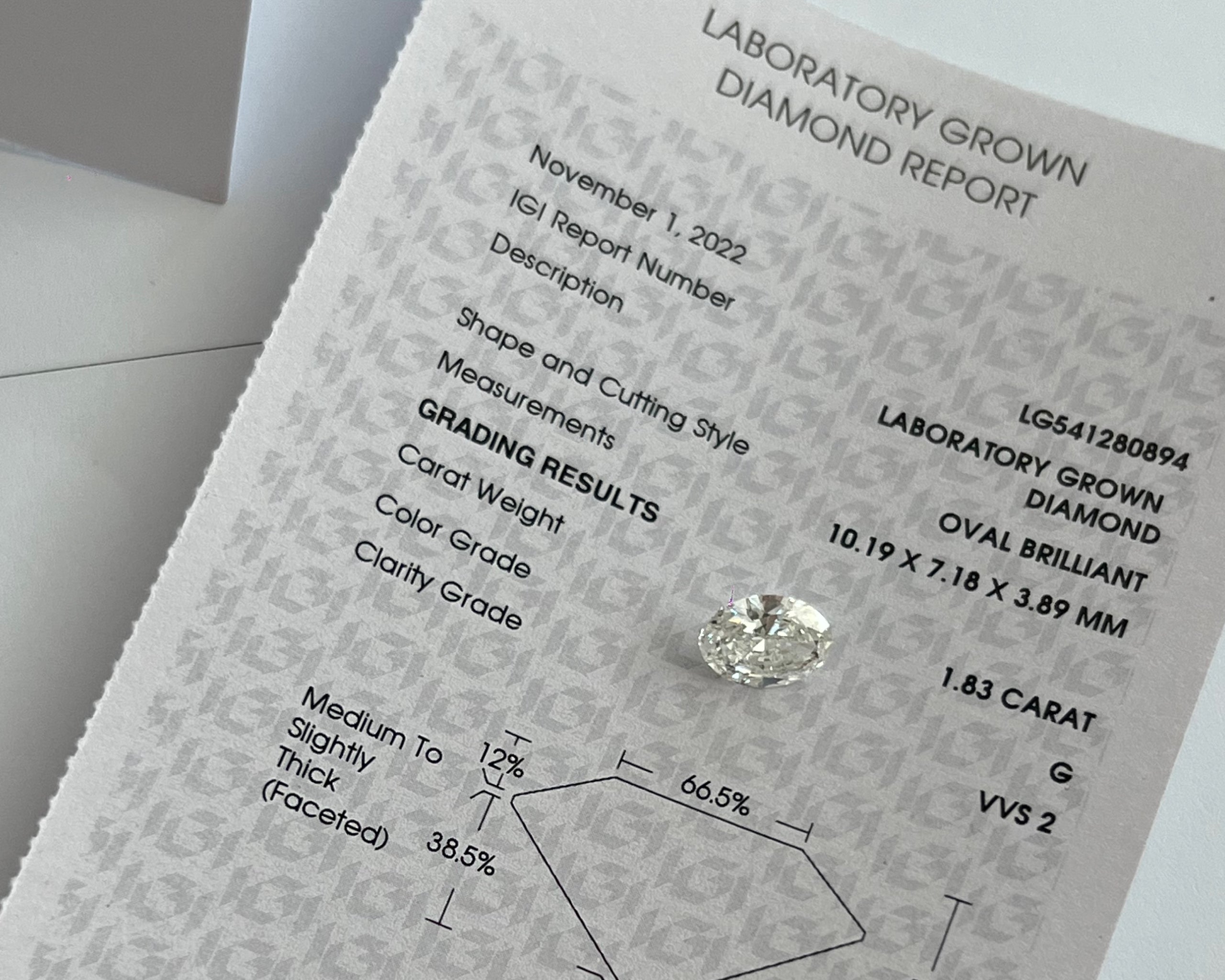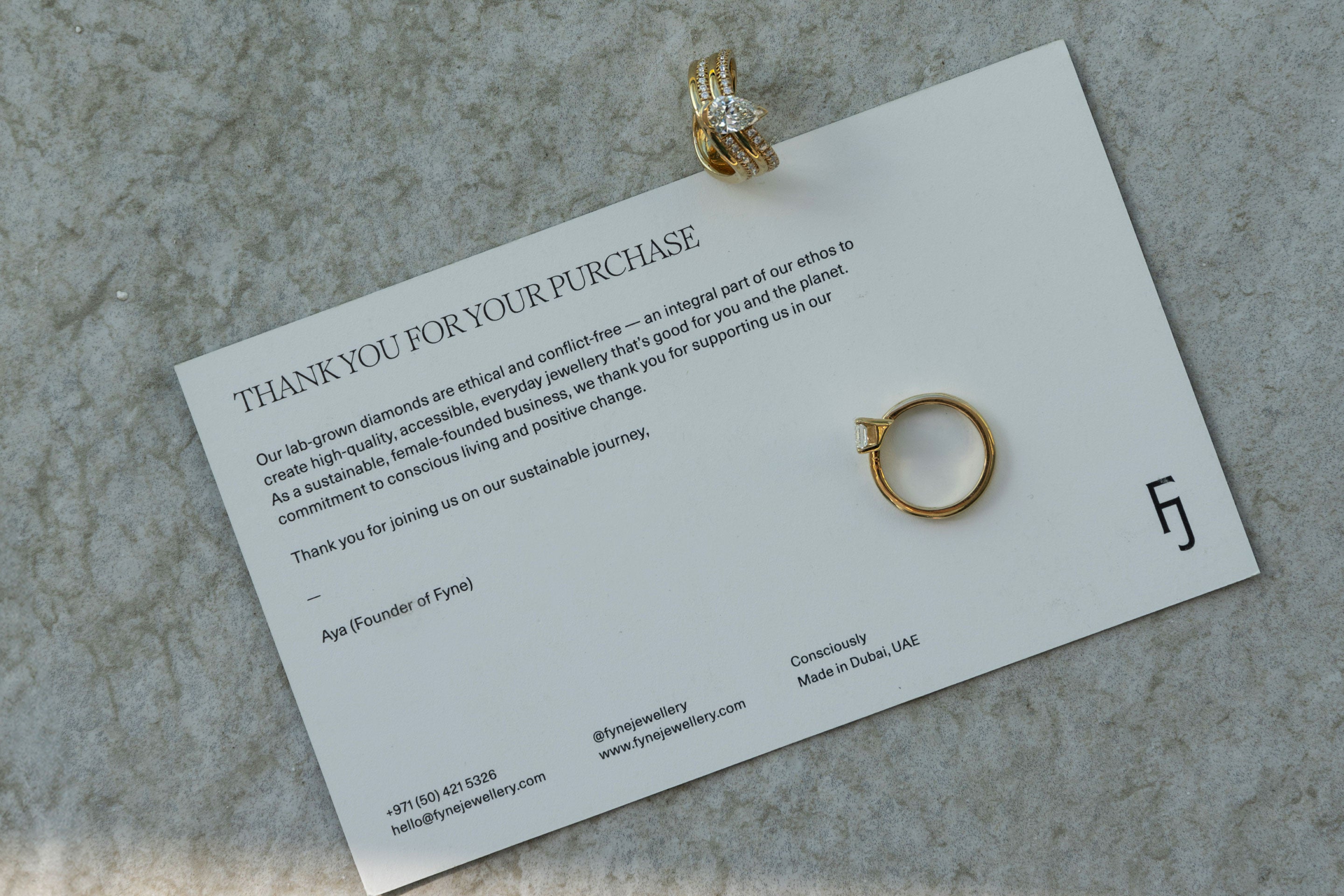Choosing the perfect diamond can feel overwhelming, with many options and varying advice regarding quality and price. At Fyne, our diamonds are created ethically in a laboratory, with a planet-first mindset, making us the first business to sell jewellery with lab-grown diamonds in Dubai.
To help you consider the best option, we’ve put together a guide to diamond clarity, one of the ‘4Cs’ used to assess a diamond’s quality. By following this guide, you’ll be on your way to understanding the diamond scale and choosing a diamond that meets your needs and your budget.
What is Diamond Clarity?
Diamond clarity explained.
Diamonds are formed in an environment under immense pressure and temperatures — either in the earth with natural diamonds or in an artificially identical setting with lab-grown diamonds.
But what does diamond clarity mean? Due to the heating process, natural marks will appear; those on the external faces of the diamond are referred to as blemishes, while those contained inside the diamond are known as inclusions. It’s important to note that these imperfections are not always visible to the naked eye. Usually, a microscope is required to study things like diamond clarity and colour.
The unique thing about diamonds is that no two are identical, whether formed in the lab or the earth, making every diamond individual in terms of value.
For a once-in-a-lifetime piece, explore Fyne’s diamond rings. Our gold jewellery with sustainable lab-grown diamonds makes the perfect engagement ring or gift for a special occasion.
The 4Cs of Diamonds
There are four diamond categories used to measure the worth of a diamond. These are cut, clarity, colour, and carat. All of these are part of the diamond quality chart, used to assess different factors of the diamond’s worth.
Cut
The cut grading is the proportions and finish of a polished diamond. This is judged by symmetry, proportions and angles. The finish is also looked at, which is a visual assessment of the brightness (brilliance), sparkle (scintillation) and fire (reflection of colours in a diamond when it moves). For example, a sharp, reflective diamond with clean edges will be valued higher than a dull-cut diamond with rough edges.
Read more about some of the most popular diamond shapes.
CLARITY
Diamond clarity reflects the relative absence of blemishes or inclusions. Within the official diamond clarity scale, there are six ratings, from ‘flawless’ at the top end to ‘included’ at the bottom end of the scale. Most of the assessments for diamond clarity will take place under 10 x magnification, as the naked eye cannot see subtle imperfections.
COLOUR
Diamonds, whether grown in the lab or the earth, often have a natural colour that can affect the price point. This colour is graded from D-Z, with D being the highest colour grading. While it's not uncommon for a diamond to have a slightly yellow or brown tint, the more colourless the diamond, the higher its market value. Diamond colour and clarity are assessed slightly differently. In the case of colour, it’s assessed by the eye in a neutral environment, using coloured paper or card.
CARAT
The fourth and final indicator of diamond value is the carat, which notes the diamond’s weight (a carat is the equivalent of ⅕ of a gram). While a larger, heavier diamond will typically cost more, the other three factors on the 4Cs indicator will be considered to dictate the final price. This means a diamond with a lower carat but flawless clarity and an excellent cut may outprice a higher-carat diamond.
For more inspiration, check out Fyne’s diamond jewellery.
How is Diamond Clarity Graded?
Introducing the diamond clarity scale.
Diamonds are graded according to how immaculate their clarity is. A diamond with the fewest blemishes and inclusions will be awarded the highest clarity grade; this will impact the value of the diamond and, therefore, its retail price.
Diamond Clarity Chart
The imperfections in a diamond’s crystal structure are assessed according to a scale. The diamond clarity chart will factor in several considerations when studying the diamond under a microscope, including the number and position of inclusions, the size and nature of the inclusions, and the colour. The diamond clarity chart is used universally by diamond experts to value diamonds.
Diamond Clarity Scale

The diamond grading scale has six main diamond categories, with further class distinctions. These are:
- Flawless and Internally Flawless (FL/IF): These diamonds are incredibly rare as almost all diamonds form naturally with some kind of inclusion. A flawless diamond won’t show any signs of blemish or inclusion under 10 x magnification.
- Very, Very Slightly Included (VVS1/VVS2): Under 10 x magnification, these diamonds only have minute inclusions that are very difficult (or extremely difficult) to spot, even to a trained eye.
- Very Slightly Included (VS1/VS2): These diamonds have minor inclusions that can be difficult (to somewhat easy) to spot by a trained expert under 10 x magnification. Even if somewhat easy to spot (VS2), they are still considered eye-clean, which means you can’t see the inclusions by the naked eye.
- Slightly Included (S1/S2): Slightly included diamonds will have noticeable inclusions that are easy or very easy for a trained grader to see under 10 x magnification.
- Included (I1,l2,l3): Diamonds at the bottom end of the scale will have obvious inclusions when studied, most of which may be visible without a microscope.
How to Choose the Right Clarity for Your Diamond
One of the most important things to consider when choosing a diamond is how it looks to the naked eye. An ‘eye-clean’ diamond has no visible blemishes or inclusions despite perhaps not sitting at the top end of the diamond rating chart. Whilst many eye-clean diamonds have blemishes under a microscope, the most important thing is that you’re happy with your diamond's appearance when you’re wearing it.
VS class diamonds are often considered eye-clean but are a little more affordable than the classes above them, making them a great compromise between affordability and beauty. It’s important to note that eye-clean diamonds are still considered extremely valuable and high quality in terms of diamond clarity.
A note from Fyne: We only use VVS to VS1 clarity diamonds in our jewellery.
To strike the perfect balance, combine the clarity rating with the other Cs (cut, colour, and carat) to find something that meets your needs and budget. Before buying a diamond, be aware of these ratings and decide in advance what things you’re willing to compromise on and where you want your diamond to sit on the diamond clarity scale. That way, you’ll find the right diamond for you.
With all of the above factors considered, we hope you have a better idea of diamond clarity and how it can affect the value and aesthetic of a diamond. The most important thing to remember is that every diamond — whether grown in the lab or formed in the earth — is totally unique, and no two diamonds will experience the same imperfections. So, whatever diamond you settle on, your diamond will be unlike any other that existed before or after it.
FAQs
What is the best clarity of diamond?
The best clarity of diamond on the diamond clarity chart is ‘Flawless’; this type of diamond is extremely rare and, therefore, high in value, as imperfections are part of the natural process of the formation of diamonds.
Which is better clarity, VS1 or VS2?
VS1 diamonds have a slightly higher clarity grade than VS2. This means that imperfections in the diamond are somewhat more challenging to spot under 10 x magnification if a diamond is classed as VS1 diamond clarity.
Does diamond clarity really matter?
Clarity is one of the four determining factors in the price of a diamond. Typically, diamonds with fewer inclusions will rate higher on the diamond clarity scale and, therefore, be of higher value. Whether this matters comes down to personal preference — each imperfection on a diamond makes it truly unique, meaning no two diamonds are alike. Diamond clarity is essential to consider when deciding upon a budget.
Note: Diamond shapes with step cuts like Emerald Cuts or Asschers should have higher clarity gradings as it is easier to see the inclusions. As such, you should always opt for VVS clarities in these cuts. However, ovals, marquises and radiants are better at hiding clarity characteristics, which means you could get away with purchasing an oval cut at VS2 clarity grading.
Which diamond clarity is most common?
VS and SI diamonds tend to be the most popular on the market. This is because they sit in the middle of the diamond clarity chart, striking a balance between price and quality. Diamonds of these classes tend to be considered ‘eye-clean’, meaning they’re free from visible blemishes, whilst still more affordable than diamonds with fewer blemishes upon microscopic inspection.





